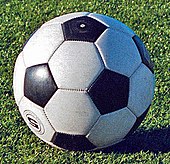
Back كرة (كرة القدم) Arabic كورة (كورة) ARY Futbol topu Azerbaijani Футбольны мяч Byelorussian Футбольны мяч BE-X-OLD Футболна топка Bulgarian বল (ফুটবল) Bengali/Bangla Nogometna lopta BS Pilota de futbol Catalan Fodbold (bold) Danish

A football (also known as a football ball, soccer ball, or association football ball specifically in the United Kingdom) is the ball used in the sport of association football. The name of the ball varies according to whether the sport is called "football", "soccer", or "association football". The ball's spherical shape, as well as its size, weight, mass, and material composition, are specified by Law 2 of the Laws of the Game maintained by the International Football Association Board.[1] Additional, more stringent standards are specified by FIFA and other big governing bodies for the balls used in the competitions they sanction.
Early footballs began as animal bladders or stomachs that would easily fall apart if kicked too much. Improvements became possible in the 19th century with the introduction of rubber and discoveries of vulcanization by Charles Goodyear. The modern 32-panel ball design was developed in 1962 by Eigil Nielsen, and technological research continues to develop footballs with improved performance. The 32-panel ball design was soon joined by 24-panel balls as well as 42-panel balls, both of which improved on performance prior to 2007.[citation needed]
A black-and-white patterned spherical truncated icosahedron design, brought to prominence by the Adidas Telstar, has become a symbol of association football.[2] Many different designs of balls exist, varying both in appearance and physical characteristics.[3]
- ^ Mazhar, Talha. "citation". fifa.com. Fifa. Archived from the original on 15 December 2022. Retrieved 15 December 2022.
- ^ Kotschick, Dieter (2006). "The Topology and Combinatorics of Soccer Balls". American Scientist. 94 (4): 350–357. doi:10.1511/2006.60.1001. Archived from the original on 3 October 2020. Retrieved 3 October 2019.
- ^ Hong, Sungchan; Asai, Takeshi (29 May 2014). "Effect of panel shape of soccer ball on its flight characteristics". Scientific Reports. 4 (1): 5068. Bibcode:2014NatSR...4E5068H. doi:10.1038/srep05068. PMC 4038026. PMID 24875291.
© MMXXIII Rich X Search. We shall prevail. All rights reserved. Rich X Search